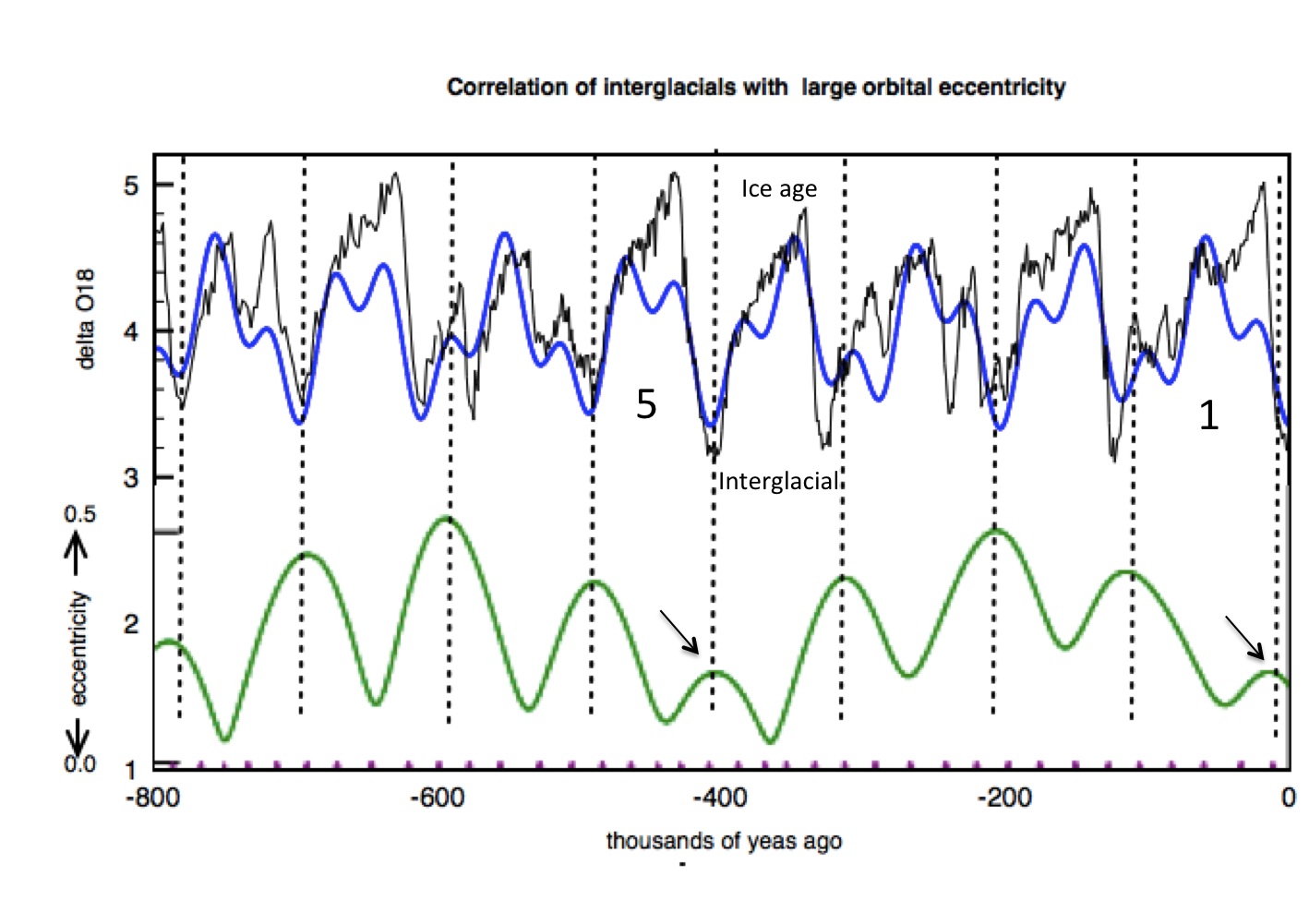The graph above illustrates how strongly the major ice ages are influenced by the orbital eccentricity of the Earth about the Sun.
Today the seasons are dominated by the tilt of the Earth’s axis–the Northern Hemisphere pointing away from the sun when the Earth is closest to the sun–and the Northern Hemisphere pointing toward the sun when the Earth is farthest from the sun.
However, today, the Earth is about 20,000 years from the last major ice age. The eccentricity, meant to tell us how perfect Earth’s orbit is (a perfect circle is an eccentricity of zero) is how the Earth orbits today, so there is little difference in distance during the seasons of summer and winter.
Notice in the graph above that the last nine major eccentricities correlate to the last nine ice ages. How this happens is that the Earth tilts based on its precession (as if it were a top, spinning but winding down in potential energy). When the Northern Hemisphere (unlike today) tilts away from the sun when the Earth is farthest away from the sun, there is less insolation (incoming heat) and so the Earth begins to cool down.
We know there are other factors in play, because there are cycles on the Earth itself: cycles in the atmosphere, hydrosphere, and lithosphere. Our climatological computer models encompass all but the biological component. And why might that be important? What effect can microorganisms have on such huge shifts in temperature?
Notice how regular the connection of ice age fluctuations to eccentricity for the last million years. Before that, there might have been less or little correlation. Why? Because as the sun cools, as anything cools, it may show regular, lower-energy fluctuations. In the last nine or ten cycles, microorganisms, or smaller snippets of evolutionary life, might have adapted to the cycling and played into it.
Next, we will confirm that more than 50% of the biomass of the Earth exists (perhaps in the form of latent primitive bacterial spores) in the crust (lithosphere). We believe carbon dioxide to be a trigger along with the sun’s incoming heat for part of the cycling, but have we considered the succession of microorganism bloom associated with these factors?
For a more complete overview of the effects of carbon dioxide on Earth’s climate, please refer to the following link: Scientific American Article on Carbon Dioxide and Climate
For more information on climate changing phenomena due to sunspot cycles: https://spaceweatherarchive.com/2018/09/27/the-chill-of-solar-minimum/
NEW MATERIAL [DECEMBER 2019]
Sometimes speculating about Earth’s climate and the effects of warming is not easy. For me, I think it’s better to look at the change in Earth’s orbit to understand how the climate of the Earth is changed when it is closer to the sun.
The closest, most similar planet to us is Venus. It took a long time for water to evaporate off its surface (a few billion years), perhaps, but just because a planet is in the Goldilocks Zone (zone of liquid water), doesn’t mean it will be favorable to multicellular organisms (primitive life will have a better chance of adapting to the exceptional heat, like at Yellowstone, our super volcano).
Both Mars and Venus, have hostile climates for different reasons. According to Bode’s Law which is just a mathematical progression, inner planets exist at approximately 30, 60, 90. and 120 million miles (though Mars has a highly eccentric orbit).
Eccentricity (how elliptical or far from circular an orbit is) means perihelion of a planet like ours will be closer to the sun for a shorter time duration (and aphelion means farther from the sun for a longer time duration). Earth has a regular change in the eccentricity of its orbit around the sun. Because of the durations of aphelion and perihelion orbits, even small eccentricities can change climate to warmer or cooler climates.
Presently our orbit is nearly perfectly circular, meaning from ice core data that every 100,000 years we enter a warming period (the time in summer is equal to the time in winter (eccentricity approximately zero)).
Summer and winter are determined by two things on Earth: how far the Earth is from the sun and how its axis is angled (which depends on precession of the axis. Like the wobbling of a top).
Here is more information of how eccentricity of the Earth’s orbit around the sun (and the precession of its axis can cause regular climate changes:https://en.wikipedia.org/wiki/Milankovitch_cycles#Orbital_shape_(eccentricity))
